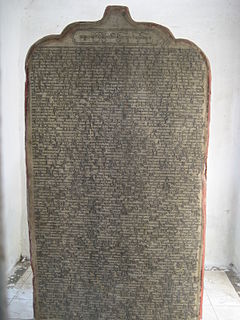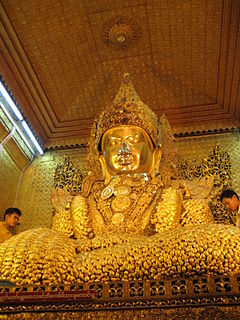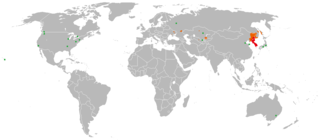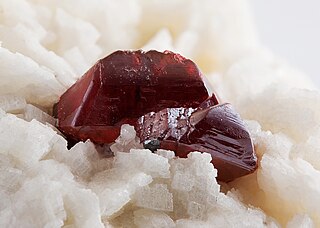
Guanyin or Guan Yin is the most commonly used Chinese translation of the bodhisattva known as Avalokiteśvara. In English usage, Guanyin refers to the Buddhist bodhisattva associated with compassion and venerated chiefly by followers of Mahayana Buddhist schools as practiced in the sinosphere. Guanyin also refers to the bodhisattva as adopted by other Eastern religions such as Taoism, where she is revered as an immortal, as well as Chinese folk religions, where the mythical accounts about Guanyin's origins do not associate with the Avalokiteśvara described in Buddhist sutras.. In English, she is often known as the "Goddess of Mercy" or the Mercy Goddess. The Chinese name Guanyin, is short for Guanshiyin, which means "[The One Who] Perceives the Sounds of the World".

Pure Land Buddhism, also referred to as Amidism in English, is a broad branch of Mahayana Buddhism and one of the most widely practiced traditions of Buddhism in East Asia. Pure Land is a tradition of Buddhist teachings that are focused on the Buddha Amitābha. The three primary texts of the tradition, known as the "Three Pure Land Sutras", are the Longer Sukhāvatīvyūha Sūtra, Amitayurdhyana Sutra and the Shorter Sukhāvatīvyūha Sūtra.

Maitreya (Sanskrit), Metteyya (Pali), is regarded as a future Buddha of this world in Buddhist eschatology. In some Buddhist literature, such as the Amitabha Sutra and the Lotus Sutra, he is referred to as Ajita.

Avalokiteśvara or Padmapani is a bodhisattva who embodies the compassion of all Buddhas. This bodhisattva is variably depicted, described and portrayed in different cultures as either male or female. In Tibet, he is known as Chenrezik, and in Cambodia as "អវលោកិតេស្វរៈ". In Chinese Buddhism, Avalokiteśvara has evolved into the somewhat different female figure Guanyin. In Japan this figure is known as Kanzeon or Kannon.

Buddhist symbolism is the method of Buddhist art to represent certain aspects of dharma, which began in the fourth century BCE. Anthropomorphic symbolism appeared from around the first century CE with the arts of Mathura the Greco-Buddhist art of Gandhara, and were combined with the previous symbols. Various symbolic innovations were later introduced, especially through [Tibetan Buddhism]

Buddhist texts were initially passed on orally by monks, but were later written down and composed as manuscripts in various Indo-Aryan languages which were then translated into other local languages as Buddhism spread. They can be categorized in a number of ways. The Western terms "scripture" and "canonical" are applied to Buddhism in inconsistent ways by Western scholars: for example, one authority refers to "scriptures and other canonical texts", while another says that scriptures can be categorized into canonical, commentarial and pseudo-canonical. Buddhist traditions have generally divided these texts with their own categories and divisions, such as that between buddhavacana "word of the Buddha," many of which are known as "sutras," and other texts, such as shastras (treatises) or Abhidharma.

There are no extant representations of the Buddha represented in artistic form until roughly the 2nd century CE, partly due to the prominence of aniconism in the earliest extant period of Buddhist devotional statuary and bas reliefs. A number of early discourses describe the appearance of the Buddha, and are believed to have served as a model for early depictions. In particular, the "32 signs of a Great Man" are described throughout the Pali Canon, and these are believed to have formed the basis for early representations of the Buddha. These 32 major characteristics are also supplemented by another 80 secondary characteristics (Pali:Anubyanjana).

Honzon, sometimes referred to as a Gohonzon, is the enshrined main image or principal deity in Japanese Buddhism. The buddha, bodhisattva, or mandala image is located in either a temple or a household butsudan.

The Mahamuni Buddha Temple is a Buddhist temple and major pilgrimage site, located southwest of Mandalay, Myanmar (Burma) (Myanmar). The Mahamuni Buddha image is deified in this temple, and originally came from Arakan. It is highly venerated in Burma and central to many people's lives, as it is seen as an expression of representing the Buddha's life.

Vasudhārā, whose name means "stream of gems" in Sanskrit, is the Buddhist bodhisattva of wealth, prosperity, and abundance. She is popular in many Buddhist countries and is a subject in Buddhist legends and art. Originally an Indian bodhisattva, her popularity has spread to southern Buddhist countries. Her popularity, however, peaks in Nepal where she has a strong following among the Buddhist Newars of the Kathmandu Valley and is thus a central figure in Newar Buddhism. She is named Shiskar Apa in Lahul and Spiti. She is related to Hindu great goddess Lakshmi, and her Sanskrit name Vasundhara indicates she is the source of the eight "bountiful Vasus." Therefore, according to the epic Mahabharat, she is the bounty that is the waters of the river Ganges—the goddess, Ganga whose origin is the snows of the Himalayas.
In English translations of Buddhist texts, householder denotes a variety of terms. Most broadly, it refers to any layperson, and most narrowly, to a wealthy and prestigious familial patriarch. In contemporary Buddhist communities, householder is often used synonymously with laity, or non-monastics.
Abhisheka or abhiṣeka is a Sanskrit term akin that means a devotional activity; an enacted prayer, rite of passage and/or religious rite. Within this range of senses, abhiṣeka is common to Indian religions such as Hinduism, Buddhism and Jainism.
Devotion, a central practice in Buddhism, refers to commitment to religious observances or to an object or person, and may be translated with Sanskrit or Pāli terms like saddhā, gārava or pūjā. Central to Buddhist devotion is the practice of buddhānussati, the recollection of the inspiring qualities of the Buddha. Although buddhānussati had been an important aspect of practice since the early period of Buddhism, its importance was amplified with the arising of Mahāyāna Buddhism. Specifically, with Pure Land Buddhism, many forms of devotion were developed to recollect and connect with the celestial Buddhas, especially Amitābha.

Theravada Buddhism defines arhat as one who has gained insight into the true nature of existence and has achieved nirvana. Other Buddhist traditions have used the term for people far advanced along the path of Enlightenment, but who may not have reached full Buddhahood.

Lingguang Temple is a Buddhist temple located on the east hillside of Mount Cuiwei (翠微山), in the Shijingshan District of Beijing. The temple is renowned for its collection of the tooth relic of the Buddha.

Thatta Thattaha Maha Bawdi Pagoda is a Buddhist temple on Udayaraṃsi hillock in Pobbathiri Township, Naypyidaw Union Territory, Myanmar (Burma). The pagoda is a replica of the Mahabodhi Temple in Bodh Gaya, Bihar, India. The replica is 162 feet (49 m) tall.


















